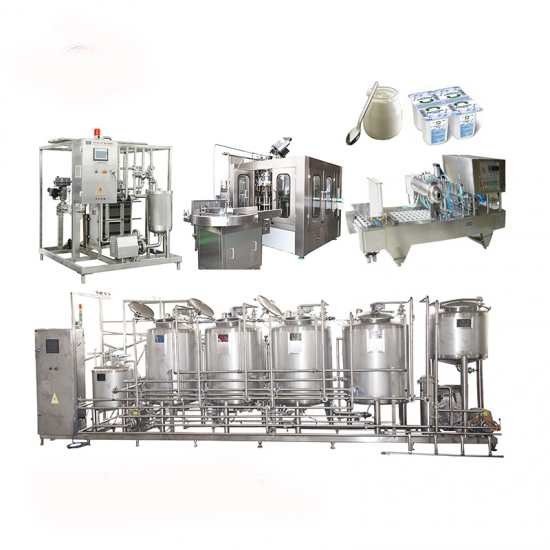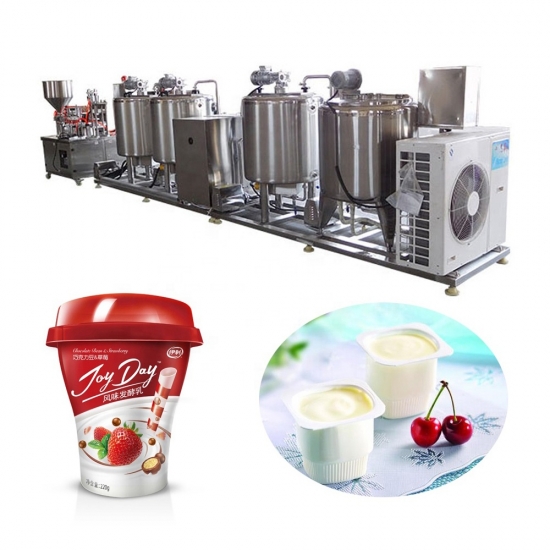Yogurt production line usually consists of multiple links, including raw material preparation, yogurt fermentation, cooling, packaging and other steps. The following is the main process of a typical yogurt production line:
1. Raw material preparation
Milk procurement and inspection: Purchase fresh milk or milk sources and conduct quality inspection to ensure compliance with standards.
Dairy ingredients: Depending on the type of yogurt product, sugar, stabilizers, fruit particles, spices, etc. may need to be added.
2. Pretreatment
Pasteurization: Heat the milk to a certain temperature (usually 85-90°C) to kill harmful bacteria and maintain nutrients.
Homogenization: Evenly distribute the fat in the milk to prevent the fat from floating up and ensure that the yogurt has a delicate taste.
3. Inoculation of fermentation bacteria
Add specific fermentation bacteria, such as Lactobacillus acidophilus and Bifidobacterium, at a suitable temperature to start the fermentation process.
The fermentation temperature is usually controlled at 40-45°C, and the fermentation time varies depending on the product type, usually 4-6 hours.
4. Post-fermentation processing
Cooling: After fermentation is completed, the yogurt is cooled to about 4°C to stop the fermentation process.
Taste adjustment: Sometimes additional flavoring ingredients such as fruits, syrups, etc. are added during this process.
5. Packaging
Filling: Fill yogurt into containers, such as cups, bottles or bags.
Sealing: Seal the container to prevent contamination.
Label: Affix information such as production date and shelf life.
6. Storage and transportation
Cold chain storage: Yogurt must be stored in a refrigerated environment to maintain its quality.
Distribution: Yogurt is distributed to major retailers and consumers through cold chain transportation.
7. Quality control
Strict quality testing is required at each link, including microbiological inspection, ingredient analysis, sensory evaluation, etc., to ensure that the product meets food safety standards.
The yogurt production line covers multiple links from raw material processing to finished product packaging, and each link requires specialized equipment to complete specific tasks. These equipment are of various types and have different functions, designed to ensure the efficiency, hygiene and stability of the production process. The choice of equipment depends not only on the scale of the production line, but also on factors such as product type, production capacity, and degree of automation. According to different production needs, the configuration and technical level of the equipment can be customized to meet the requirements of different manufacturers and markets. The following is a detailed expansion of the equipment selection and customized design of each link of the yogurt production line:
1. Customization of raw material processing equipment
The first step in yogurt production is raw material processing, especially the quality inspection and preliminary processing of milk. In order to ensure that the raw materials meet the standards, the accuracy and efficiency of raw material processing equipment are crucial.
Milk quality inspection equipment: including milk fat content tester, lactose analyzer, microbial incubator, acidometer, etc. Different detection accuracy may be required for different production needs. For example, in high-end yogurt production, more stringent microbial testing of milk may be required to ensure that it does not contain any pathogens.
Pasteurizer (pasteurization equipment): Pasteurization is an indispensable step in yogurt production. The design of the pasteurizer can be customized according to the scale of the production line. For example, a small-scale manual production line may use a small pasteurizer, while a large-scale automated production line requires a large, efficient pasteurization equipment that can handle more milk while maintaining the efficiency of heat exchange.
Homogenizer: The main function of the homogenizer is to break the fat particles in the milk and distribute them evenly. Production lines of different sizes may require homogenizers of different power and capacity. For high-end products that require fine control of the taste of yogurt, homogenization equipment with more precise adjustment functions may be required.
2. Equipment customization during fermentation
The fermentation process determines the taste, texture and flavor of yogurt, so when choosing equipment for the fermentation process, manufacturers usually customize it precisely according to the product type and production scale.
Fermentation tank: The design of the fermentation tank requires precise control of temperature, humidity and stirring speed to ensure the uniform distribution of bacteria and the smooth progress of the fermentation process. For small and medium-sized production lines, simpler manually controlled fermentation tanks may be used, while large production lines may use highly automated and digitally controlled fermentation tanks. These devices can monitor and adjust parameters such as temperature, humidity, pH value in real time to ensure the accuracy of fermentation.
Temperature control system: In order to ensure that the fermentation process is carried out within the appropriate temperature range, the temperature control system is crucial. For different fermented products, the temperature control system may require different levels of accuracy. For example, for traditional yogurt that requires a long fermentation period, the temperature control system may focus more on long-term stability at low temperatures; while for fast-fermented yogurt, the temperature control system needs to quickly adjust the temperature in a short period of time.
Stirring system: In some production lines, the fermentation tank may be equipped with a stirring system to help the bacteria to be evenly distributed. The design and speed of the stirring equipment can be customized according to different fermentation requirements to ensure the uniform texture of the yogurt.
3. Equipment selection for cooling and taste adjustment
The cooling process and taste adjustment of yogurt directly affect its quality, so the equipment design of these two links needs special attention.
Cooling equipment: Cooling is a key step to stop fermentation and ensure the delicate taste of yogurt. The selection of cooling equipment is closely related to the scale and output of production. Small-scale production lines may use simple coolers, while large-scale production lines may use efficient plate coolers or pipeline cooling systems, which can quickly reduce the temperature of yogurt in a short time, thereby ensuring the freshness and taste of yogurt.
Taste adjustment equipment: In order to enhance the flavor of yogurt, many production lines will add fruit particles, spices, syrups and other ingredients after cooling. At this time, the selection of the stirring system is very important. It needs to be adjusted according to the type and viscosity of the ingredients to ensure that all ingredients are evenly mixed to avoid uneven taste.
4. Customization of packaging equipment
Packaging is the last link in the yogurt production line and a key part to ensure product hygiene, safety and market appeal. With the increasing demand of consumers for environmentally friendly and convenient packaging, the selection of packaging equipment is gradually becoming more diversified and intelligent.
Filling machine: The choice of filling equipment depends on the type and specification of the container. Common packaging forms include cups, bottles, bags, etc. The speed, accuracy and automation level of the filling machine will vary for different product types. For example, high-end yogurt or specific flavored yogurt may require more precise filling volume control to ensure consistent content in each package; while large-scale production lines may use efficient automated filling machines that can complete the filling of large quantities of products in a short time.
Sealing machine: The choice of sealing equipment is closely related to the material of the yogurt container. For plastic cups or bottled yogurt, the sealing machine usually uses heat sealing technology, while for bagged yogurt, cold sealing or pressure sealing technology is required. The speed and sealing quality of the sealing machine directly affect the shelf life and hygiene of the yogurt.
Labeling machine and packaging machine: The design of labeling and packaging systems is usually customized according to the specifications and packaging methods of the product. For example, an automated labeling machine can efficiently and accurately apply labels to containers to avoid misalignment or damage. The packaging machine is responsible for sealing and packaging the yogurt boxes and finally preparing them for transportation. These devices usually use automated control to improve production efficiency and reduce labor costs.
5. Application of automation and digital control
With the development of industrial automation and digital technology, modern yogurt production lines are gradually becoming highly automated, and the intelligence of equipment is also constantly improving. The automation of equipment can not only improve production efficiency, but also reduce human errors and ensure the stability of product quality.
Automated control system: Modern production lines are usually equipped with automated control systems, which can monitor various parameters in the production process in real time, such as temperature, humidity, pH value, acidity, and the amount of bacteria added, to ensure accurate control of the production process. At the same time, the system can be adjusted according to the set standards to avoid affecting product quality due to human operating errors.
Data traceability and quality control: Advanced equipment is usually equipped with data acquisition and analysis systems to record various data in the production process. These data can not only help manufacturers trace quality, but also optimize production processes through analysis and improve overall production efficiency.
There are many types of equipment for yogurt production lines, and each link from raw material processing to finished product packaging is supported by special equipment. The selection and customization of equipment usually requires reasonable decisions based on production scale, product type and degree of automation. With the continuous advancement of production processes and technologies, yogurt production line equipment is gradually developing in the direction of high efficiency, hygiene and intelligence, providing yogurt producers with higher production capacity, more precise product quality control and more flexible production methods. In the future, the automation and intelligence level of yogurt production lines will continue to improve, providing more optimized solutions to meet the diverse needs of the market.

